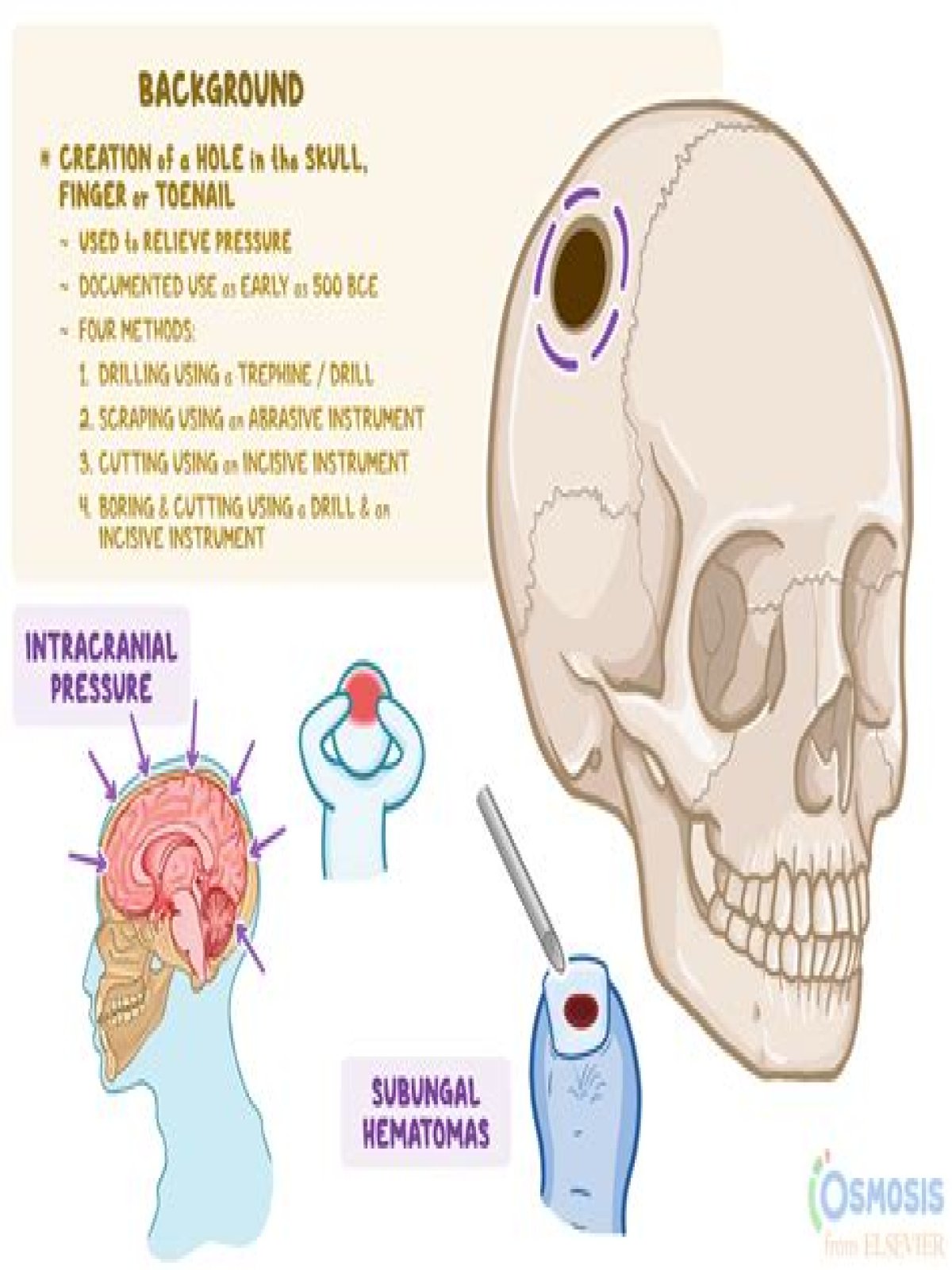trepanation
This procedure — also known as “trepanning” or “trephination” — requires drilling a hole into the skull using a sharp instrument. Nowadays, doctors will sometimes perform a craniotomy — a procedure in which they remove part of the skull to allow access to the brain — to perform brain surgery.
› articles
- When did they drill holes in skulls?
- Did doctors used to drill holes in skulls?
- Why did doctors drill holes in skulls?
- Who first used trepanation?
- Drilling holes in skulls | By Richard P. Holm, MD
- When was the first craniotomy performed?
- When did trepanation stop?
- Are lobotomy still practices?
- Can you live with a hole in your skull?
- How long does it take to recover from burr hole surgery?
- What is the difference between lobotomy and trepanation?
- Do we still use Trephination?
- Why was trepanning done?
- What is believed to be the oldest surgical procedure?
- How did they drill holes in medieval times?
- What are medical burr holes?
- Do burr holes heal?
- Does skull bone grow back together?
- What is the hole in the skull called?
- What does it feel like to be lobotomized?
- What does lobotomy do to a person?
- Was there ever a successful lobotomy?
- Was trepanation successful?
- Did cavemen do brain surgery?
- Did Romans do brain surgery?
When did they drill holes in skulls?
The oldest discovered skulls showing evidence of trepanation date back to the Mesolithic period — around 6000 B.C. They emerged in North Africa, Ukraine, and Portugal.Did doctors used to drill holes in skulls?
As early as 7000 years ago, one of the alternative medicine practice was boring holes in the patient's neurocranium with the aim to cure and not to kill. Similar to bloodletting, trepanation was carried out for both medical reasons and mystical practice.Why did doctors drill holes in skulls?
According to the French physician Paul Broca, ancient physicians were quite familiar with trepanation in which a hole was made in the skull by cutting or drilling it. They did so to alleviate pressure on the brain following an injury to the head, or to release evil spirits from the heads of mentally ill people (4).Who first used trepanation?
The famous Greek physician Hippocrates wrote of this practice being used when someone's head was indented or bruised. During the Middle Ages and into the 16th century, trepanning continued to be used frequently.Drilling holes in skulls | By Richard P. Holm, MD
When was the first craniotomy performed?
There is evidence that craniotomy—more accurately, trepanation, or creating a permanent hole in the skull as opposed to replacing the skull fragment—was in use up to 8,000 years ago. Skulls between 5,000 and 8,000 years old with marks of trepanation had been found in France as early as 1685¹.When did trepanation stop?
The treatment was largely practiced until the early 16th century. An article in the journal World Neurosurgery reported that trepanation was widely practiced throughout China thousands of years ago.Are lobotomy still practices?
Today lobotomy is rarely performed; however, shock therapy and psychosurgery (the surgical removal of specific regions of the brain) occasionally are used to treat patients whose symptoms have resisted all other treatments.Can you live with a hole in your skull?
"Physical damage to one part may be fatal, but in another it may have very little effect." Rose adds: "If the lower regions of the brain or spinal cord are damaged - regions that control heart rate, breathing etc - the consequences are likely to be fatal.How long does it take to recover from burr hole surgery?
Most patients will spend at least a few days recovering in the hospital. However, some patients will require a much longer hospital stay, such as following a stroke or traumatic brain injury. After you are released from the hospital, you will begin your recovery at home.What is the difference between lobotomy and trepanation?
Trepanation is also used for surgical access to help relieve intracranial pressure. Lobotomy is another surgical treatment that involves drilling a hole in a person's skull.Do we still use Trephination?
Is trepanation still used today? Trepanation is not used in neurosurgery for medical purposes now. However, another procedure, called a craniotomy, is done that involves temporarily creating a hole in the skull to remove fluids or release pressure, and then closing the hole after a definite period.Why was trepanning done?
By Galen's time (129–199) trephining was in standard use in treating skull fracture for relieving pressure, for gaining access to remove skull fragments that threatened the dura, and, as in Hippocratic medicine, for drainage.What is believed to be the oldest surgical procedure?
TrepanationTrepanation (drilling or scraping a hole in the skull) is the oldest form of surgery we know of. Humans have been performing it since neolithic times. We don't know why people did it, but some experts believe it could have been to release demons from the skull.
How did they drill holes in medieval times?
Drilling HolesThe first crude drilling tool was the awl, a sharp stone, flint, copper or bone point that could be attached to a piece of wood. The awl was pressed against an object and then rotated by hand, much like a present-day screwdriver.
